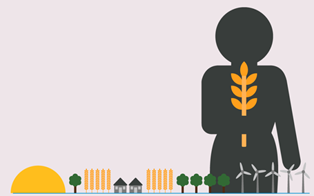‘Equality’ to Women could reduce Malnourished People by 12-17%
- 16 Oct 2021
Food systems worldwide depend on the labour of rural women.They raise and process crops, and prepare and distribute their products, ensuring that their families and communities are nourished.

- However, these same women often have less access to food, and suffer higher risk of hunger, malnutrition and food insecurity, when compared with men.
- Discriminatory gender norms often see them eating last, or least, in the household, where they are also responsible for the greater share of unpaid caregiving and domestic work.
- Improving the lives of rural women is key to fighting poverty and hunger. Giving women the same opportunities as men could rise agricultural productionby 2.5 to 4 per cent in the poorest regions and the number of malnourished people could be reduced by 12 to 17 percent.
- Achieving gender equality and empowering women is not only the right thing to do but is a critical ingredient in the fight against extreme poverty, hunger and malnutrition.
- This year’s International Day of Rural Women (15 October), with the theme "Rural women cultivating good food for all" highlights the role of rural women in agricultural production and subsequent contribution towards fight against extreme poverty, hunger and malnutrition (critical role they play in feeding the world).
Contribution of Rural Women to Development
- Women account for a substantial proportion of the agricultural labour force, including informal work, and perform the bulk of unpaid care and domestic work within families and households in rural areas. They make significant contributions to agricultural production, food security and nutrition, land and natural resource management, and building climate resilience.
- On average, women make up more than 40 percent of the agricultural labour force in developing countries, ranging from 20 percent in Latin America to 50 percent or more in parts of Africa and Asia.
- Smallholder agriculture produces nearly 80% of food in Asia and sub-Saharan Africa and supports the livelihoods of some 2.5 billion people.
Barriers Rural Women Face
Multi-Dimensional Poverty
- Women and girls in rural areas suffer disproportionately from multi-dimensional poverty. While extreme poverty has declined globally, the world’s 1 billion people, who continue to live in unacceptable conditions of poverty, are heavily concentrated in rural areas. Poverty rates in rural areas across most regions are higher than those in urban areas.
Discrimination/Exclusion
- Access: Women farmers may be as productive and enterprising as their male counterparts but are less able to access land, credit, agricultural inputs, markets, and high-value agri-food chains and obtain lower prices for their crops. Women and girls in rural areas lack equal access to productive resources and assets, public services, such as education and health care, and infrastructure, including water and sanitation, while much of their labour remains invisible and unpaid, even as their workloads become increasingly heavy due to the out-migration of men.
- Participation: Structural barriers and discriminatory social norms continue to constrain women’s decision-making power and political participation in rural households and communities.
- Exclusion: Globally, with few exceptions, every gender and development indicator for which data are available reveals that rural women fare worse than rural men and urban women and that they disproportionately experience poverty, exclusion, and the effects of climate change.




